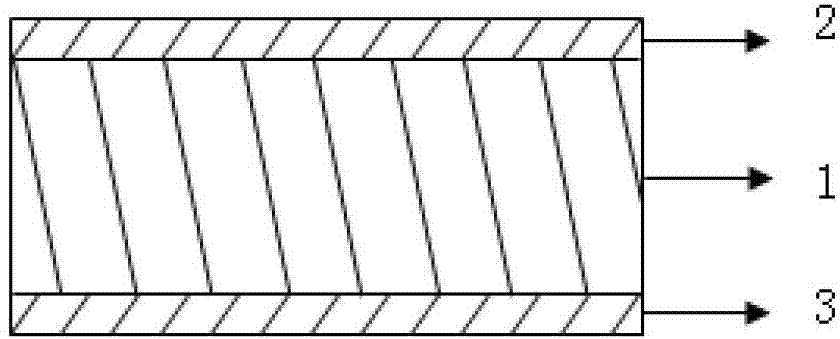High-sag-resistance composite brazing aluminum foil and preparation method thereof
A brazing, high-resistance technology, used in chemical instruments and methods, metal rolling, layered products, etc., can solve the problems of coarse recrystallized grains and difficult to obtain, and achieve the effect of inhibiting corrosion and improving sag resistance.
- Summary
- Abstract
- Description
- Claims
- Application Information
AI Technical Summary
Problems solved by technology
Method used
Image
Examples
Embodiment 1
[0024] Embodiment 1: 2 kilograms of 4343 alloys are used as the upper and lower cladding layers of the composite foil, and the 4343 aluminum alloys are melted at a melting temperature of 680° C. After the alloy is melted, a refining agent with a weight of 2 grams of molten aluminum is added, and the refining agent consists of 18% chlorine Sodium Chloride, 32% Potassium Chloride, 10% Hexachloromethane, 6% Potassium Fluoroborate, 15% Sodium Fluoroaluminate and 19% Charcoal Powder; by blowing nitrogen or inert gas Stir the aluminum melt for purification treatment. After stirring for 3 minutes, let it stand for 5 to 10 minutes to clean the aluminum slag on the surface of the aluminum melt, and cast it into a 20mm thick aluminum alloy plate with an iron mold. The iron mold is preheated at 100°C. The cast 4343 alloy plate is placed in a muffle furnace, heated at 460° C., kept for 15 minutes, and then released from the furnace. The alloy plate is hot-rolled into an aluminum alloy plat...
Embodiment 2
[0025] Embodiment 2: 2 kilograms of 4343 alloys are used as the upper and lower cladding layers of the composite foil, and the 4343 aluminum alloy is melted at a melting temperature of 650° C. After the alloy is melted, a refining agent with a weight of 2.5 grams of molten aluminum is added, and the refining agent is composed of 18% chlorine Sodium Chloride, 32% Potassium Chloride, 10% Hexachloromethane, 6% Potassium Fluoroborate, 15% Sodium Fluoroaluminate and 19% Charcoal Powder; by blowing nitrogen or inert gas Stir the aluminum melt for purification treatment. After stirring for 3 minutes, let it stand for 8 minutes to clean the aluminum slag on the surface of the aluminum liquid, and cast it into a 20mm thick aluminum alloy plate with an iron mold. The iron mold is preheated at 100°C; the cast 4343 alloy plate Put it in a muffle furnace, heat it at 465°C, keep it warm for 20 minutes, take it out of the furnace, and hot-roll the alloy plate into a 2.5mm aluminum alloy plate...
Embodiment 3
[0026]Embodiment 3: 2 kilograms of 4343 alloys are used as the upper and lower cladding layers of the composite foil, and the 4343 aluminum alloy is melted at a melting temperature of 700° C. After the alloy is melted, a refining agent with a weight of 2.0 grams of molten aluminum is added, and the refining agent is composed of 18% chlorine Sodium Chloride, 32% Potassium Chloride, 10% Hexachloromethane, 6% Potassium Fluoroborate, 15% Sodium Fluoroaluminate and 19% Charcoal Powder; by blowing nitrogen or inert gas Stir the aluminum melt for purification treatment. After stirring for 3 minutes, let it stand for 8 minutes to clean the aluminum slag on the surface of the aluminum liquid, and cast it into a 20mm thick aluminum alloy plate with an iron mold. The iron mold is preheated at 100°C; the cast 4343 alloy plate Put it in a muffle furnace, heat it at 480°C, keep it warm for 20 minutes, take it out of the furnace, and hot-roll the alloy plate into a 2.5mm aluminum alloy plate....
PUM
| Property | Measurement | Unit |
|---|---|---|
| melting point | aaaaa | aaaaa |
Abstract
Description
Claims
Application Information
 Login to View More
Login to View More - R&D
- Intellectual Property
- Life Sciences
- Materials
- Tech Scout
- Unparalleled Data Quality
- Higher Quality Content
- 60% Fewer Hallucinations
Browse by: Latest US Patents, China's latest patents, Technical Efficacy Thesaurus, Application Domain, Technology Topic, Popular Technical Reports.
© 2025 PatSnap. All rights reserved.Legal|Privacy policy|Modern Slavery Act Transparency Statement|Sitemap|About US| Contact US: help@patsnap.com

